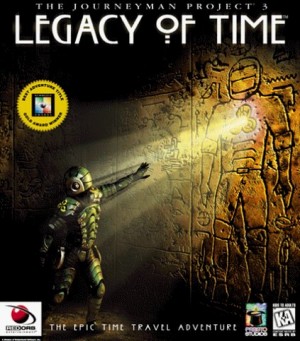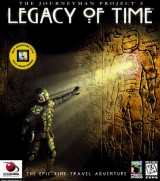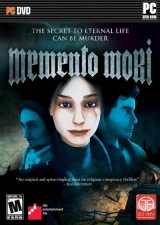Review for The Journeyman Project 3: Legacy of Time
Game Design 101 pop quiz, class!
When you're the developer of two successful installments of an adventure trilogy, do you make the third game:
A) a carbon copy of the existing template (the "don't mess with success" model)
B) a slightly modified and polished version of the first two games (the "tune-up as needed, but if it ain't broke, don't fix it" model)
C) a significant redesign that pushes the series in a new but risky direction (the “Journeyman Project 3" model)
If you answered A or B, you've grown too accustomed to the sequel-itis disease that has infected the gaming industry. (You also happen to be extremely unobservant, since I tucked a brilliantly subtle clue in the question, but this is about games, not you.) Fortunately for adventurers, when the trilogy in question is the Journeyman Project, and the developer is Presto Studios, the answer is a resounding C.
They say the third time's a charm, and Presto was hoping that proved true with their 1998 release of The Journeyman Project 3: Legacy of Time, the final entry in their time travelling sci-fi series. They obviously listened closely to the criticism of the previous games, but they weren't prepared merely to implement the changes needed to silence the complaints. Instead, they went back to the drawing board to create a refreshingly different gameplay experience. No doubt some will argue that they changed too much (and that's the risk of alienating established fans), but when all is said and done, the finale is not only the most accessible of the three games, but the best of them.
Legacy of Time picks up several months after the conclusion of Journeyman Project 2, in the year 2329. The dramatic turn of events at the end of the second game remains unresolved. Although the manual blatantly reveals the identity of the culprit in the previous story, I'll just say that this nemesis is lost in the time stream, and presumed dead. Meanwhile, the interplanetary Symbiotry (a galactic United Nations, basically) is now pressuring Earth to dismantle its time travelling devices, having had two separate disasters only narrowly averted. Unable to justify its own mismanagement of the technology, the Temporal Security Agency (TSA) is ordered to suspend all time travel. Of course this is the worst possible timing, as shutting down leaves no means to protect history against the potential influence of the missing villain. Lucky that person's dead, right? Oops. Maybe not.
No sooner has the TSA effectively crippled its conventional security, than a massive time distortion occurs, and the only hope is an untested prototype jumpsuit. Once again assuming the role of the heroic Agent 5, Gage Blackwood, we hop into our new time travelling duds, and after a brief demonstration, our adventure begins. Actually, before doing any real adventuring, we run smack dab into the cause of the temporal rip—a jumpsuit abandoned by our former foe with a recorded plea to follow the trail of clues through three exotic historical locations to a new and much more sinister alien crisis.
Veterans of the series will appreciate the seamless way the third game continues the narrative established by the first two. However, it certainly isn't necessary to have played those to enjoy Legacy of Time. Presto has done a nice job of recapping the relevant facts, and with their usual attention to detail, even include a plausible explanation why you may have no memory of past events. Before long, everyone will be feeling right at home in the Journeyman universe.
The first thing you'll invariably notice about the game is... its large viewscreen!! If you're perplexed about the emphasis, then you haven't yet played the first two games, which utilized a—shall we say… compact viewable area, to put it charitably. The artistic aspect of the graphics has been stellar throughout the series, but Legacy of Time is the first game to demonstrate the beautiful design in an adequate scale. Now you can admire the waters of the Mediterranean, a sunset in the Andes, and the snowy landscapes of the Himalayas without having to squint. The larger image does have a tradeoff, however, as the graphics are rather pixelated. Nevertheless, this move was a much-needed step in the right direction.
Like its predecessors, Legacy of Time plays from a first-person perspective with node movement. Transition between nodes is cinematically animated with no loss of graphical quality, which is a rare achievement. This time around, each node offers full 360-degree smooth panning, which is another huge improvement over the choppy directional view feature of Journeyman Project 2. It still isn't quite as comfortable as other games employing the same engine type, however. Panning requires clicking and dragging the cursor, and since all movement functions have also been moved onscreen, you'll undoubtedly find yourself clicking the forward arrows instead of panning. It sounds like a small adjustment, but it'll likely happen enough to become an annoyance. A few other sacrifices are also made as a natural consequence of using this updated engine. Backgrounds are now noticeably blurry, and there is very little animation to help bring the game world to life. Still, most players will find that the ability to freely look around more than atones for the shortcomings in other areas.
Along for the ride again is Arthur, the nasal-voiced, fast-talking, irreverent, know-it-all artificial intelligence with a penchant for 20th century pop culture. As in the second game, Arthur is not only the most entertaining feature by far, but an integral aspect of the gameplay, as well. Throughout your trek, Arthur will make observations that provide key plot or puzzle details. He'll also indicate that he has further helpful clues to offer if you so desire, but these need to be manually accessed. Beyond serving as an in-game hint system, he's also a treasure trove of historical and cultural information, and a (disembodied) stand-up comedian, to boot. One minute he'll be offering an exposition on the tyranny of Genghis Khan, and the next he'll be doing sendups of the Godfather, Marvin the Martian, and Gilligan's Island. Combining learning and laughter is an elusive formula, but Presto pulls it off again. Much of this is optional, though, so for those precious few who might find Arthur more irritating than endearing, you're free to limit his contribution.
Where the developers venture into entirely new territory is not in the presentation or mechanics, but in the gameplay. The first two games were designed around the inability to interact with any other humans. This made sense from a time travelling perspective, but the result was a lonely, limited gaming experience. In Journeyman Project 3, that dilemma is bypassed entirely by the "chameleon" technology of the new jumpsuit. We can now capture a holographic image of any people we see, and project the disguise perfectly onto Gage. This allows us to interact freely with the other inhabitants. In fact, it's a requirement, and a substantial one at that. A healthy portion of the game will be spent conversing with other characters. The chameleon feature provides an ongoing puzzle of its own, as figuring out which character can obtain what information from whom is part of the challenge. It's not difficult, but it certainly adds a completely new level of depth and a much different atmosphere than the previous games.
The characters you meet are all presented in FMV clips that are integrated smoothly into the background graphics, and the acting runs hot and cold. Many of the smaller supporting roles are performed very well, but a handful of others are notably weak. Included in the latter is Gage, himself, who seems to be permanently bug-eyed and bewildered.
Conversations offer no real dialogue choices, as you merely exhaust all available options. As some of the responses can be quite lengthy, this is the least interactive part of any of the Journeyman games, and really slows down the pace. Fortunately, the scripting itself is consistently excellent, and serves to flesh out the compelling mythology of the lost civilizations you're exploring—namely, El Dorado, Shangri-La, and (don't cringe) Atlantis. Each individual narrative is skillfully crafted and tied nicely to the overarching futuristic storyline, which regrettably comes across through lengthy cutscenes as hackneyed sci-fi camp. The discrepancy is rather jarring, but ultimately not enough to spoil the experience.
The quality of the aural experience in the Journeyman games has continued to improve here, as the sound effects and ambient noises are uniformly excellent. The music has been scaled back from the last game, and is now only present in specific locations. The scores are all soothing and mellow, and you may not even notice at first that you've moved from music into silence, or vice versa. Very effective.
There are several cases of addition by subtraction in Journeyman Project 3. Blissfully absent this time around are the many punishing death and failure screens from the previous games. Legacy of Time wisely abandons that philosophy, and won't let you fail under any circumstances. Also gone is the pressure of timed sequences, so the game can be enjoyed at a leisurely pace from beginning to end. The awkward onscreen interface has finally been streamlined, as well, and the new version is much more intuitive. On the flip side, very few objects can be viewed or manipulated if they don't relate directly to a puzzle, and the interactivity in the game world is sorely missed this time around.
As in the previous games, progression will require some tactical time hopping, as items from one era will be needed in another. I'd have preferred to see Presto eliminate this convention, also, as it weakens the cohesion, and in this case, imposes unnecessary disc-swapping (unless you have the rare DVD version). At least the time travel now returns you to the precise spot you left, which eliminates a lot of backtracking experienced previously.
Legacy of Time continues the Journeyman trend of avoiding arbitrary puzzles in favour of well-integrated obstacles with logical solutions. Aside from the inventory and chameleon challenges, there are relatively few pure puzzles along the way. There is a devious maze puzzle that may cause some people problems even with a map for navigation, and the final puzzle is a doozy that will tempt many gamers to appeal to Arthur for help. Such occasions are few and far between, however, meaning Journeyman Project 3 shouldn't take longer than 10-15 hours to complete, if that.
Of the entire trilogy, Legacy of Time is the only game I recommend on its own. If you're a science-fiction fan, by all means consider the series as a whole, as the continuity in the Journeyman universe makes each successive game more enjoyable. However, if you're simply looking for an entertaining adventure to whisk you away to ancient (and future) cultures, tell a story of mystery and myth, provide some laughs and challenge your mind occasionally, this is your game. Its much-improved accessibility over the previous titles, along with the prominent character interaction, makes for a slightly more passive experience but much tighter package overall which has something to offer every adventure gamer.






























